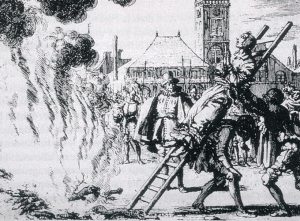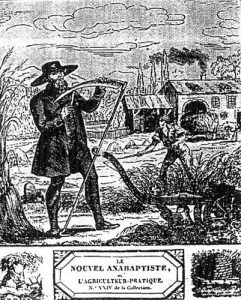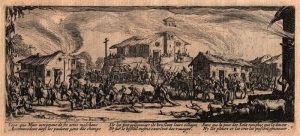The sixteenth century Anabaptists
Anabaptism is one of the currents of the sixteenth century radical Reformation. It originated in Switzerland. It differs from the Lutheran or Calvinist Reformation in that it refused child baptism. Its adepts advocated adult believers’ baptism and re-baptised those who had received child baptism. Hence the term “Anabaptist” (or “daïfer” in Alsace), meaning “re-baptiser”. They likewise refused to be armed, to exercise a public function and to take oath.
This pacifist tendency was considered seditious and dangerous. In 1529 the Turks were outside Vienna and threatened the Western world. Anabaptists were chased away and persecuted without mercy.
Welcomed in Strasburg by the Reformers Bucer and Capiton, they soon spread all over Alsace. They held secret meetings and travelled throughout Alsace preaching evangelical pacifism. They were imprisoned, especially in Riquewihr where their presence was of considerable size. Executions, however, were rare. At the end of the sixteenth century, repression abated and the Anabaptist doctrine spread.
Swiss immigration
The seventeenth century was deeply affected by the upheavals of the Thirty-Year war (1618-1648). Except for a few towns, Alsace became French in 1648. The entire province was devastated and its population annihilated as a result of disease, famine and military action. After the war, the king and the princes did their utmost to encourage immigration by offering fallow lands and tax breaks. These measures attracted numerous Swiss Anabaptists.
In 1635-36, there was an upsurge of persecution in the canton of Zurich, the cradle of Anabaptism. Because of their pacifism, Anabaptists were considered as rebels. Adults were jailed, children placed in foster care and possessions confiscated. The situation was similar in the canton of Berne of in 1670-71 with, in addition to other measures, deportation on Venetian galleys.
With the support of the Dutch Reformed community and the Alsace Anabaptists, the Swiss Anabaptists managed to overcome numerous difficulties and emigrate to Alsace. From 1650 onwards, they settled where no one else wanted to do so and restored farms and windmills on a number of domains, particularly in the Ribeaupierre County. Anabaptists gathered in this area known for its religious tolerance. Although Anabaptism first developed in cities, it then became rural. Some people from Basel and from Holland joined these communities. In 1660, at the Ohnenheim windmill, they adopted a common confession of faith. This confession of faith is still in use in the Amish communities in the United States.
Anabaptists obtained the right to gather in remote areas. The offices of preacher, elder and deacon were elective. Besides the Bible, Anabaptists used a hymnal called “Ausbund”. Most of its hymns had been composed in prison by fellow believers. It is still in use amongst the Amish.
The advent of the Amish community
At the end of the seventeenth century, about sixty families from the Berne area settled in the valley of Sainte-Marie-aux-Mines under the leadership of Jacob Amann. The latter, referred to as the “patriarch”, felt offended by the lifestyle and discipline of the Alsatian Anabaptist community. He requested more rigorous rules, in particular a dressing code advocating a more simple attire. The new community named “Jacob Amann’s party” was later to be named “the Amish” in the United States. It originated in 1693 after their separation from the Anabaptists (in Alsace, they are still referred to as “Daïfer”). They mostly gathered around Sainte-Marie-aux-Mines and, as a result of their hard work, thrived economically. They acquired the largest farms and estates in the valley. Their herds, very productive, were the largest in the area.
They managed to obtain some benefits :
- Exemption from local military service
- Exemption from work as town tax-collectors
- Exemption from taking oaths, the latter being replaced by the “Handtreue” (tapping with one another’s hand as a sign of commitment).
In exchange of these benefits they were asked a financial compensation.
The success of these Anabaptists soon roused jealousy.










